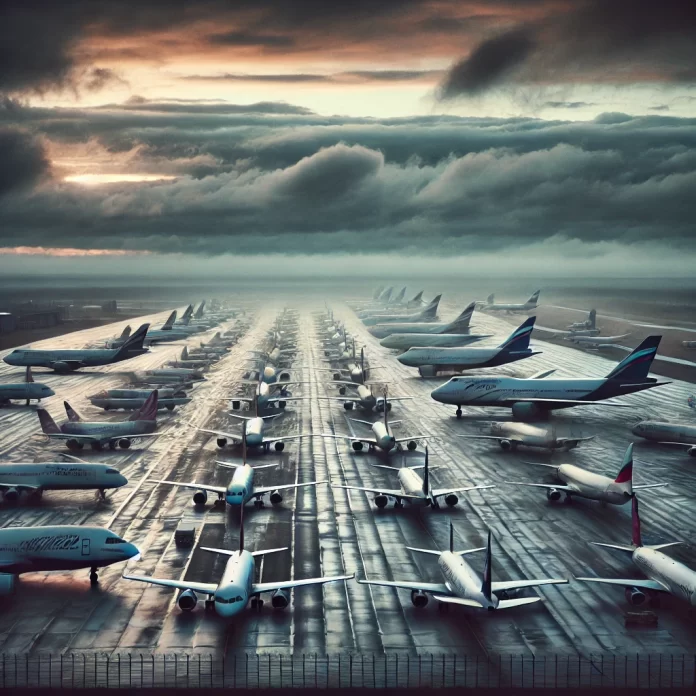In a troubling turn for Russian aviation industry, nearly 30 airlines responsible for more than a quarter of the nation’s domestic passenger traffic are on the brink of bankruptcy. Many of these airlines are smaller companies with limited resources, now facing massive debt linked to the leasing of foreign aircraft. The situation has become more critical as these debts have grown due to the economic consequences of international sanctions imposed over recent years.
Russian Aviation Sector Faces Unprecedented Financial Strain
The sanctions, introduced in 2022, created financial barriers that stopped many airlines from paying for their leased aircraft. As a result, debts started accumulating, adding considerable pressure to these airlines’ already tight budgets. In response, the Russian government is working on a plan to relieve some of this debt by allowing airlines to write off portions of it in 2025.
However, this relief comes with a high price: a 25% tax on the written-off debt, which will significantly impact the financial stability of these smaller carriers. Some may not have the resources to handle this tax burden, pushing them closer to bankruptcy.
Major airlines are in a slightly better position. Large carriers have started repurchasing some of their leased aircraft, using government funds to do so, which helps them avoid the debt and tax burdens altogether. By early 2024, they had bought back nearly half of their previously leased aircraft. Smaller airlines, however, lack the capital to take similar steps and face a challenging road ahead.
Rising Maintenance Costs Add to Financial Challenges
Financial troubles in Russian aviation sector go beyond leasing debts. Before sanctions took effect, many Russian airlines relied on maintenance services from Western countries where their aircraft were registered, such as Europe and Bermuda. With these services cut off, airlines had to look for alternative maintenance support from countries like Iran, Turkey, and China. This shift has sharply increased costs, as these services often come with higher price tags.
For instance, the monthly maintenance cost for an Airbus A320 has spiked, reaching anywhere from $80,000 to $150,000, a much higher amount than airlines previously paid. Experts argue that taxing the written-off lease debts as “income” is inaccurate, given that airlines must allocate a large portion of their funds toward keeping these aircraft operational.
The increased expenses in maintenance have placed immense pressure on the financial health of these airlines, and the additional tax only complicates their situation. The tax on written-off debts will be treated as “non-operating income” and taxed as profit, creating a significant financial hurdle. Industry leaders are pushing for changes in the tax code to prevent this tax from further straining the airlines. They propose that any funds saved from debt relief be used to maintain and repair planes, ensuring that they remain airworthy without compromising safety due to financial constraints.
Without these changes, smaller airlines could struggle to stay in business, as the increased costs of aircraft upkeep combined with the new tax burden make it nearly impossible for some to sustain operations.
Workforce and Production Shortfalls Highlight Operational Hurdles
The sanctions have significantly impacted Russia’s ability to source parts, trained personnel, and critical services, as major Western manufacturers have halted their support. To address the shortage of aircraft and maintenance services, the Russian government has allocated over $12 billion to support local aircraft production and provide financial aid to airlines. However, the industry still struggles with resource shortages, notably in trained pilots and accessible, high-quality maintenance.
These shortages came into sharp focus in the summer of 2024 when a pilot shortage forced several flight cancellations at Russia’s main airports. The shortage of trained personnel highlights how critical the lack of resources has become for Russian airlines. It has also underscored the broader logistical challenges as the aviation industry adapts to operating without Western support.
To bridge this gap, the Russian government has set ambitious goals for producing domestically made aircraft, aiming to build up to 1,000 planes by 2030. However, delays in production timelines for new aircraft models have pushed back their availability. Manufacturing new aircraft has proven slower than expected, with the launch of some models now delayed to 2025 and 2026. These delays hinder the country’s plans to become self-sufficient in aviation resources and reduce reliance on foreign planes.
Additionally, Russia has been exploring partnerships with Central Asian countries to allow their airlines to operate flights within Russia. This strategy would help to meet the growing demand for air travel domestically and provide temporary relief from the aircraft shortage. However, this approach raises concerns, as Central Asian airlines could potentially face secondary sanctions from Western countries if they partner with Russia. This possibility adds a layer of risk to the potential partnership, creating hesitation among the Central Asian airlines that would otherwise be valuable collaborators.
These operational and financial difficulties reveal the profound effects of sanctions on Russian aviation sector. With limited access to essential resources and rising costs, the industry faces numerous challenges. The combination of high debt, increased maintenance costs, and a heavy tax burden on debt relief may drive several smaller airlines to shut down in the coming years, fundamentally reshaping the country’s aviation landscape.


